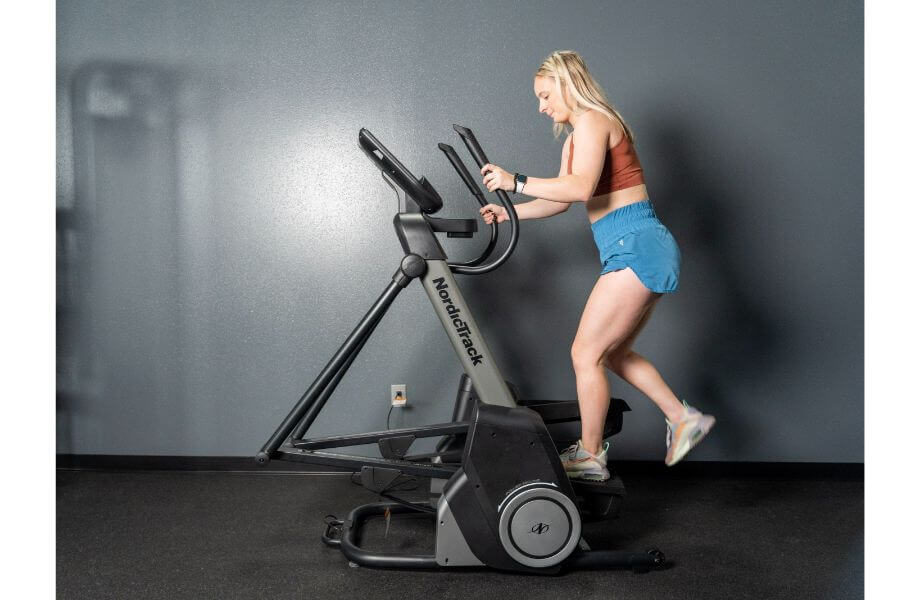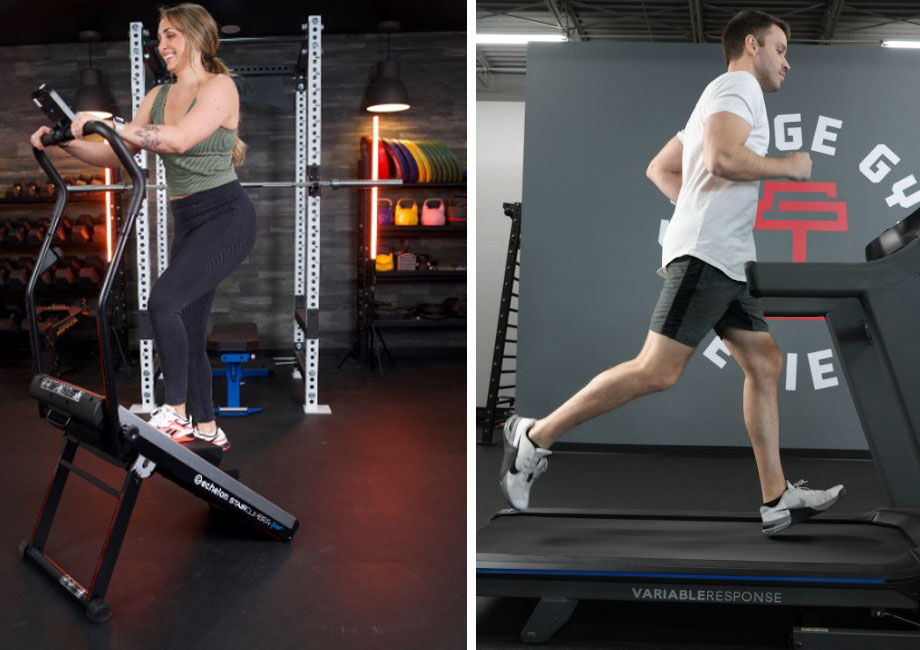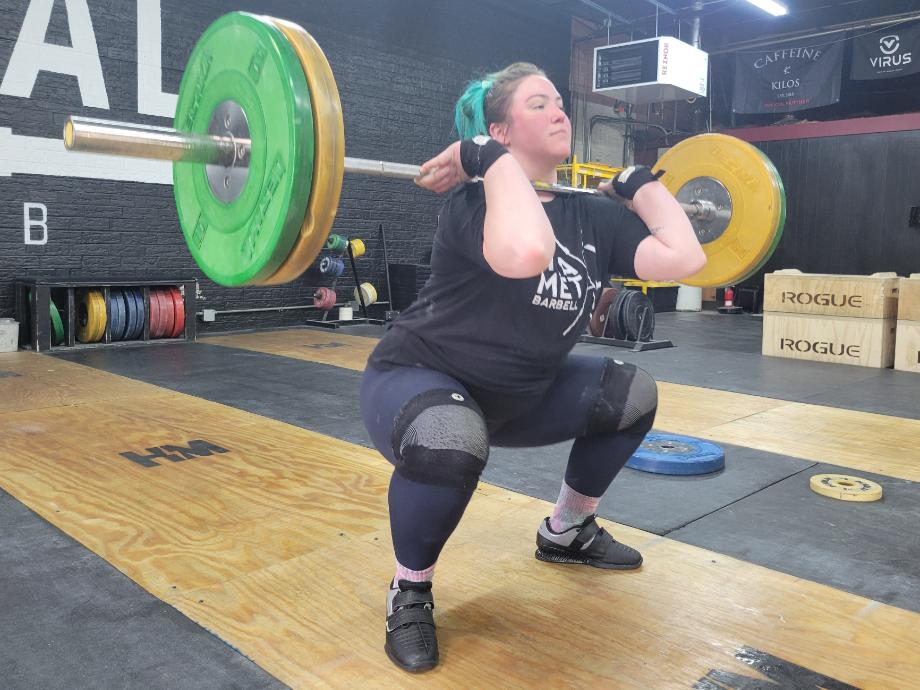Imagine two paths: one leads to an endless set of stairs, and the other paves the way to the freedom of the open road. Both paths promise to elevate your heart rate, burn calories, and strengthen your muscles, but each offers a unique journey. Welcome to the ultimate cardio showdown: StairMaster vs running.
Whether you’re focused on losing body fat, improving your heart health, or finding a cardio workout that fits your lifestyle, understanding the benefits and challenges of each type of exercise can help you make an informed decision. As a certified personal trainer (CPT) and longtime rugby player, I’ve used the StairMaster and running to help my clients (and myself) get in shape.
RELATED: Jogging Vs Running
From understanding the mechanics of the StairMaster to exploring the various forms of running, you’ll gain a thorough understanding of how each exercise impacts your body. By the time you cross the finish line, you’ll be equipped with the knowledge to decide which type of workout is the best fit for your fitness journey.
Quick Look: StairMaster Vs Running
StairMaster and running are two highly effective forms of cardiovascular exercise, each offering unique benefits. The StairMaster, also known as a stair climber or stair stepper, is a popular cardio machine in commercial gyms that provides a low-impact, high-intensity workout that targets lower-body muscles and is favored for its joint-friendly nature.

In contrast, running, a versatile and accessible activity, is renowned for its high calorie burn and cardiovascular improvements, making it a staple in fitness routines worldwide.
Who Should Use a StairMaster
- Individuals with joint issues: The StairMaster’s low-impact design is ideal for those with knee, hip, or joint concerns.
- Beginners: Its adjustable resistance and pre-programmed workouts suit those new to exercise.
- Lower-body fitness seekers: The StairMaster specifically targets lower-body muscles, making it great for glutes, quads, hamstrings, and calves.
RELATED: Best Stair Climbers
Who Should Run
- People who want a full-body workout: Running involves your legs, core, and upper body, providing a more comprehensive workout.
- Outdoor enthusiasts: Running offers the freedom to explore different terrains and enjoy the outdoors.
- Individuals aiming for weight loss: Running is a high-intensity workout that burns a significant number of calories, which can help you achieve the caloric deficit necessary for weight loss.
- Athletes training for endurance: Running is excellent for building cardiovascular fitness and stamina—both of which are necessary for athletic endeavors.
RELATED: How To Start Running
StairMaster Vs Running: What Are They?
Understanding the basics of the StairMaster and running can help you appreciate how each exercise works and what makes them distinct from each other.
StairMaster Overview
The StairMaster debuted in the fitness world in the ‘80s and quickly gained popularity due to its ability to simulate the action of climbing stairs. Unlike traditional stair climbing, which can be hard on the joints due to the impact of descending, the StairMaster provides a controlled, continuous motion that focuses on the ascent.
RELATED: StairMaster Vs Treadmill
Different Ways to Utilize the StairMaster
The StairMaster is designed with a set of rotating steps that mimic the motion of climbing stairs. The machine allows for adjustable speeds and resistance levels, catering to various fitness levels and workout intensities. By continuously climbing, users engage in a high-intensity, low-impact workout that targets multiple muscle groups simultaneously.

- Steady-state climbing: Maintain a consistent speed and resistance level for a prolonged period, ideal for endurance training.
- HIIT (high-intensity interval training): Alternate between high-intensity bursts and recovery periods to maximize calorie burn and cardiovascular benefits.
- Reverse climbing: Step backward to engage different muscle groups, such as the hamstrings and glutes, providing a well-rounded lower-body workout.
- Single-leg steps: Focus on one leg at a time to increase strength and balance, enhancing muscle symmetry and stability.
RELATED: Steady-State Cardio Vs HIIT
Running Overview
Running is one of the oldest and most accessible forms of aerobic exercise, with a rich history that dates back to ancient times. It is a fundamental human activity, deeply ingrained in cultures worldwide. Running requires minimal equipment and you can do it almost anywhere, making it a popular choice for people of all ages and fitness levels.
RELATED: Running Statistics And Facts
Different Ways To Run
Running offers unparalleled freedom and versatility. Whether you run on a treadmill, around your neighborhood, or through a scenic trail, the experience can be tailored to your preferences.

Here’s a breakdown of the different types of runs you can go on:
- Jogging: A low- to moderate-intensity running form suitable for beginners and those looking to maintain a steady pace over longer distances.
- Sprinting: High-intensity bursts of speed for short distances, focusing on power and explosive strength.
- Trail running: Running on natural terrains like forests, hills, and mountains, enhancing balance and engaging various muscle groups.
- Incline running: Incline treadmill running or hill training increases the intensity by forcing your muscles to work harder to overcome resistance.
- Interval running: HIIT workouts that alternate between periods of high-intensity running and low-intensity recovery are ideal for improving speed and metabolic conditioning.
- Marathon running: Long-distance running that requires extensive endurance training and mental fortitude.
RELATED: Elliptical Vs Running
Key Similarities Between the StairMaster and Running
While the StairMaster and running have distinct differences, they share several key similarities that make them both excellent choices for your cardio training program.
Both Provide an Effective Cardiovascular Workout
Both the StairMaster and running allow you to enjoy the benefits of cardio. Engaging in either activity will elevate your heart rate, improve your lung capacity, and enhance your overall cardiovascular fitness. Research shows that cardiovascular exercise has multiple benefits, including:
RELATED: 11 Surprising Benefits of Running
Both Engage Your Lower-Body Muscles
The StairMaster and running engage your lower-body muscles, including the quadriceps, hamstrings, glutes, and calves. Both forms of exercise help build strength, endurance, and muscle tone in the lower body, contributing to your overall fitness and performance.
RELATED: Does Cardio Build Muscle?
Both Help Burn Calories
One of the main attractions of the StairMaster and running is their ability to burn many calories in a relatively short amount of time. According to the American Council on Exercise’s (ACE) physical activity calorie counter, a 190-pound person can burn about 344 calories in 30 minutes of stair climbing.

Running also requires a significant energy expenditure. According to the ACE calculator, a 190-person can burn about 430 calories by running at a speed of 5 miles per hour for 30 minutes. If you ramp up the pace to 8 mph, that person can burn nearly 600 calories in just 30 minutes.
RELATED: Activities That Burn the Most Calories
Important Differences Between the StairMaster and Running
When choosing between the StairMaster and running, the devil is in the details. While both deliver powerful cardio benefits, the differences in impact, muscle engagement, and accessibility can make one a better fit for your fitness journey.
Impact On Your Joints
Running is a high-impact exercise that stresses the joints, particularly the knees and ankles, which can lead to injuries or exacerbate existing joint issues. In contrast, the StairMaster offers a lower-impact aerobic workout, reducing the risk of joint injuries while providing effective cardiovascular exercise.
RELATED: Low-Impact Cardio
Muscle Engagement
While both exercises target the lower body, the StairMaster provides more focused strength training for the glutes and quads. On the other hand, running offers a more balanced full-body workout, engaging your core muscles and upper body.

Equipment and Accessibility
Running requires minimal equipment—just a good pair of running shoes—and you can do it almost anywhere, making it highly accessible.
The StairMaster, however, is a piece of cardio equipment that can cost between $1,500 and $5,000, making it a more significant investment for a home gym setup. Or, you will at least need a gym membership to access this machine.
RELATED: Best Running Shoes
Common StairMaster Mistakes
Using the StairMaster incorrectly can reduce its effectiveness and potentially lead to injuries, even for the most experienced gym-goers. Here’s what you need to be mindful of to keep climbing in the right direction:
Incorrect Posture
Leaning too heavily on the handlebars can reduce the workout’s effectiveness and strain your back and shoulders. Maintain an upright posture, engaging your core muscles for balance and stability. Using the handlebars only for light support ensures that your lower body does the majority of the work.
Overestimating Your Abilities
Starting with too high a speed or resistance level can lead to quick fatigue, improper form, and potential injuries. It’s essential to begin at a manageable pace and gradually increase the intensity as your fitness improves. Pushing too hard too soon can also lead to burnout and decreased motivation.
Neglecting the Warm Up and Cool Down
Just like with running, skipping warm-up and cool-down routines when using the StairMaster can increase the risk of injuries and reduce the effectiveness of your workout. A proper warm-up prepares your muscles and joints for the intense workout, while a cool-down helps your body recover. Incorporate dynamic stretches before your workout and static stretches afterward to maintain flexibility and prevent stiffness.

RELATED: The 10 Best Warm-Up Exercises
Improper Foot Placement
Stepping too close to the edge of the steps or not fully engaging with the pedal can lead to inefficient movement and potential missteps. Ensure your entire foot makes contact with each step to engage the correct muscle groups and maintain balance. Proper foot placement enhances the workout’s effectiveness and reduces your risk of tripping or slipping.
Lack of Variation in Workouts
Repeating the same routine on the StairMaster can lead to plateaus in fitness progress and increased boredom. Mixing up your workouts by adjusting the speed and resistance or incorporating interval training can keep your sessions challenging and effective. Trying different techniques, such as reverse climbing or single-leg steps, can also engage different muscle groups and enhance your overall fitness.
Common Running Mistakes
Even seasoned runners can fall into bad habits that undermine their performance and increase their risk of injury. Here are common mistakes you want to avoid:
Poor Running Form
Improper running form can lead to a variety of injuries5, including shin splints, knee pain, and back issues. Maintain an upright posture with a slight forward lean, relaxed shoulders, and arms swinging naturally at your sides. Overstriding—taking steps that are too long—can also increase the impact on your joints and reduce running efficiency.
RELATED: Good Running Form For Beginners
Incorrect Footwear
Wearing the wrong type of shoes can cause discomfort and injuries such as blisters, plantar fasciitis, and stress fractures. It’s important to invest in a good pair of running shoes that provide adequate support and cushioning tailored to your foot type and running style. Replacing shoes regularly, approximately every 300 to 500 miles, can also prevent wear-related injuries.

RELATED: How Long Do Running Shoes Last?
Inadequate Hydration
Not drinking enough water before, during, and after runs can lead to dehydration, negatively impacting your performance and recovery. Proper hydration helps regulate body temperature, lubricates joints, and transports nutrients for energy. Carry a water bottle or wear a hydration vest on longer runs to ensure you stay adequately hydrated.
RELATED: Best Hydration Vests For Running
Ignoring the Warm-Up and Cool Down
Skipping warm-up and cool-down routines can increase the risk of injuries and decrease performance. A proper warm-up prepares your muscles and joints for the run, while a cool-down helps your body gradually return to its resting state. Incorporate dynamic stretches before running and static stretches afterward to maintain flexibility and prevent stiffness.
RELATED: 3 Treadmill Warmup Ideas
Overtraining
Running too much without adequate rest can lead to overuse injuries, such as stress fractures, tendonitis, and burnout. Listen to your body and incorporate rest days into your training schedule. Gradually increase the mileage and intensity to allow your body to adapt and recover properly.
RELATED: 10 Signs of Overtraining
How to Incorporate the StairMaster and Running Into Your Workout Routine

Sample StairMaster Workouts
- Beginner: Start with 15 to 20 minutes of steady-state climbing at a low resistance, gradually increasing the duration and intensity as fitness improves.
- Intermediate: Incorporate interval training, alternating between 1 to 2 minutes of high resistance and 1 to 2 minutes of low resistance for 20 to 30 minutes.
- Advanced: Add reverse climbing and single-leg steps into your routine, and aim for 30 to 45 minutes of varied intensity workouts.
RELATED: 3 Beginner Cardio Workouts
Sample Running Workouts
- Beginner: Start by jogging for 15 to 20 minutes at a comfortable pace, focusing on maintaining proper form.
- Intermediate: Incorporate interval running, alternating between 1 minute of sprinting and 1 minute of jogging for 20 minutes.
- Advanced: Add hill sprints, trail runs, and long-distance runs to challenge different muscle groups and improve endurance.
RELATED: 7 Sprint Workouts
How To Choose Between the StairMaster and Running
When deciding between the StairMaster and running for your cardio workouts, consider the following factors to ensure you make the best choice.
Your Fitness Goals
If you seek a low-impact workout focusing on lower-body strength, the StairMaster may be more suitable. Running is ideal for those looking for a high-intensity, full-body workout.
Impact on Your Joints
Consider the StairMaster if you have joint issues or are recovering from an injury. Its low-impact design reduces stress on your knees, hips, and lower back. Running is better suited for those with healthy joints who prefer high-impact, high-intensity workouts.

Environment Preferences
Running might appeal more if you enjoy outdoor activities and the flexibility to change your training scenery. Of course, you can also stay indoors and knock out an effective treadmill workout, too.
On the other hand, the StairMaster is ideal for those who prefer a consistent indoor workout environment.
RELATED: Treadmill Vs. Outside Running
StairMaster Vs Running: Final Thoughts
In the great cardio showdown between the StairMaster and running, there’s no definitive winner—just the one that best suits your goals and preferences. Whether you’re climbing your way to stronger glutes on the StairMaster or pounding the pavement to improve your endurance, the only direction to move is forward. Embrace the journey, listen to your body, and let each step or stride bring you closer to a healthier, fitter you.
Remember, the path to fitness is unique to you—so lace up those shoes or step up to the machine and get started!
StairMaster Vs Running: FAQs
Are StairMasters better than running?
It depends on your fitness goals; StairMasters provide a low-impact, lower-body-focused workout, while running offers a high-impact, full-body workout.
Does the StairMaster burn belly fat?
When combined with a healthy diet and consistent exercise routine, the StairMaster can help burn overall body fat, including belly fat. However, spot targeting or spot reduction is a myth.
Why is the StairMaster so hard?
The StairMaster is challenging because it requires continuous effort to lift your body weight with each step, heavily engaging your leg muscles.
Is a StairMaster or treadmill better for weight loss?
Both are effective, but treadmills may offer higher calorie burn due to the ability to vary speed and incline, making them slightly better for weight loss.
What are the benefits of using a StairMaster compared to running outdoors?
The StairMaster offers a controlled, low-impact environment ideal for those with joint issues, while running outdoors provides mental health benefits from nature and varied terrain.
References
- Pinckard, K., Baskin, K. K., & Stanford, K. I. (2019). Effects of Exercise to Improve Cardiovascular Health. Frontiers in cardiovascular medicine, 6, 69. https://doi.org/10.3389/fcvm.2019.00069
- Kandola, A., Ashdown-Franks, G., Stubbs, B., Osborn, D. P. J., & Hayes, J. F. (2019). The association between cardiorespiratory fitness and the incidence of common mental health disorders: A systematic review and meta-analysis. Journal of affective disorders, 257, 748–757. https://doi.org/10.1016/j.jad.2019.07.088
- Dolezal, B. A., Neufeld, E. V., Boland, D. M., Martin, J. L., & Cooper, C. B. (2017). Interrelationship between Sleep and Exercise: A Systematic Review. Advances in preventive medicine, 2017, 1364387. https://doi.org/10.1155/2017/1364387
- Nieman, D. C., & Wentz, L. M. (2019). The compelling link between physical activity and the body’s defense system. Journal of sport and health science, 8(3), 201–217. https://doi.org/10.1016/j.jshs.2018.09.009
- Running: Improving Form to Reduce Injuries. (2015). The Journal of orthopaedic and sports physical therapy, 45(8), 585. https://doi.org/10.2519/jospt.2015.0503






